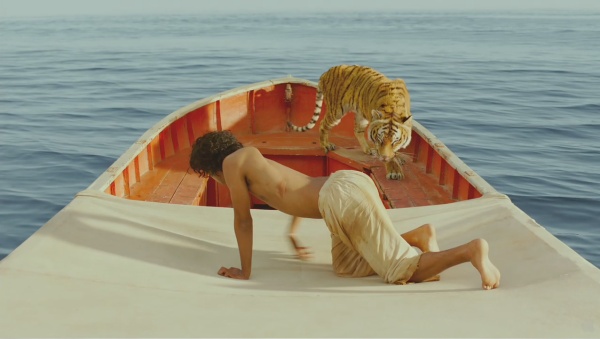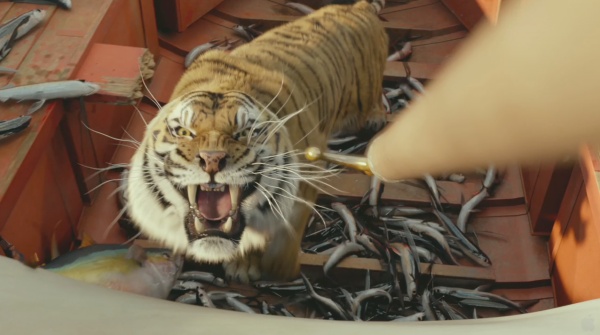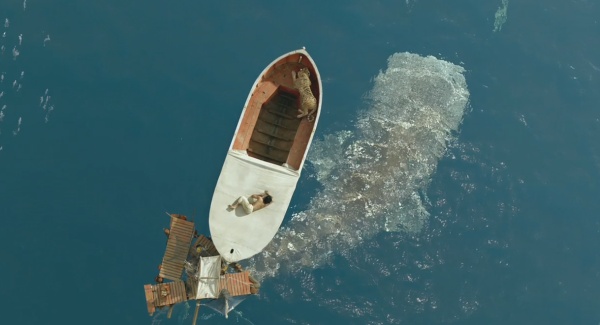Life of Pi (Ang Lee, 2012)

Ang Lee’s Life of Pi is one of the most visually beautiful movies I have seen. So was his Brokeback Mountain. But here’s the thing: the two films are beautiful in totally different ways. Lee is such a strong and versatile director that he seemingly reinvents himself for each movie; you could love every one of his movies but still not consider him as your favourite director, because he’s like a different one each time.
The film is an adaptation of Yann Martel’s novel about Pi, an Indian teenager whose family decide to relocate their zoo to Canada. While on the journey across the Pacific their ship sinks, and Pi is left stranded alone in a lifeboat with four of the zoo animals: a zebra; an orang-utan; a hyena; and a Bengal Tiger with the unlikely name of Richard Parker. This central lifeboat sequence is the core of the film, but is placed in the context of Pi’s spiritual journey. Pi has embraced multiple religions, and his adventure – narrated by the older Pi in a framing flashback – is used to illuminate his particular approach to faith.
The inclusion of the animals made this a special-effects movie, requiring as it does a largely computer-generated tiger in a central role. That crucial effect is amazing: realised by a team at Rhythm and Hues, it is a new high-water mark in photorealistic digital animals. It is vital that we believe the tiger because at the simplest, surface level, that central creature effect drives the film’s narrative. While Lee (along with Martel and screenwriter David Magee) has bigger concerns, the nuts-and-bolts of how Pi survives while sharing a confined space with such a dangerous animal are a fascinating foundation upon which to build. Richard Parker is effectively one of the leads of the film, and the relationship between he and Pi and is touching without ever getting too sentimental. The film never anthropomorphises the tiger, or downplays what a dangerous creature he is.

What is impressive about the way Lee uses special effects is that the technology has shaped itself to his filmmaking, not the other way around. So many special-effects laden films seem to be built around the strengths of the technology, giving us lots of the things computers are good at: vast crowds; strange creatures; elaborate sci-fi cityscapes; and so on. While Life of Pi has one or two spectacular effects sequences – notably the very exciting shipwreck – for the most part Lee uses special effects as another tool in his creative palette, using them judiciously to add to the dreamlike, hyper-real look of the film. (That includes 3-D, which Lee employs extremely creatively: while Lee doesn’t change my mind about the format – any more than these guys convince me we should all ride unicycles – he does demonstrate what a truly visionary director can do with it). While Lee has made effects-heavy movies before, I couldn’t help but contrast this with the much more traditional aesthetics of Brokeback Mountain (built on old-fashioned cinematography and a great eye for composition and location) and marvel at Lee’s versatility.
Not everything in the film works as well as the central lifeboat sequence. The structuring flashback device is a little clunky, and you can feel it being pushed to the foreground to cover the difficulties of adapting a challenging novel: at key moments we break into expository dialogue to explain a plot point or hammer home a theme. (Weirdly, there’s actually a double narration, since we get voiceover passages from Pi’s diary within the flashback). And I’m not sure there’s any real thematic depth here that can match the poetry of Lee’s imagery. But who cares? The film is such a visual feast, and such an extraordinary adventure story, that it is more than satisfying on those terms alone.
